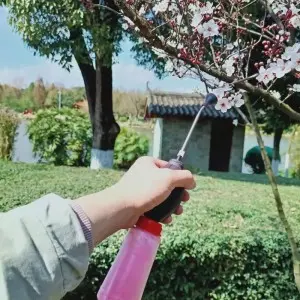Oct . 07, 2025 10:20 Back to list
Artificial Pollination: Boost Yields with Precision?
Inside the Orchard: a Field Note on artificial pollination and Lithium Tools
If you’ve walked a block of apples after a cold snap, you know the stakes. Bloom windows are tighter, bees are fussy in wind, and labor? Scarce, to be honest. That’s why growers keep asking me about lithium-powered solutions. I spent a week with the LITHIUM ELECTRIC POLLINATOR FOR ORCHARD—researched for five years and now protected by an international utility-model patent—and took notes like a nervous packhouse auditor.

What’s changing in orchards right now
- Climate variability pushes bloom-synchrony off-kilter; backup artificial pollination becomes insurance rather than a luxury.
- Lithium cells got lighter and safer (with real standards behind them), so growers can cover 10–20 mu (≈1.6–3.3 acres) without feeling like a pack mule.
- Traceability and consistent set are trending—processors want uniform fruit size; growers are responding with dosage-controlled powder application.
Product snapshot and specs (real-world, not brochure-perfect)
The unit combines a lithium battery, compact electric motor, powder storage tank, and a telescopic extension rod. Origin matters to some buyers, so here it is: Caozhuang Development Zone, Fanzhuang Town, Zhao County, Shijiazhuang, Hebei Province.
| Model | LITHIUM ELECTRIC POLLINATOR FOR ORCHARD |
| Battery | Li-ion pack, ≈36 V, 8–12 Ah (runtime ≈4–6 h, use-dependent) |
| Motor | Brushless DC, ≈300–500 W; variable flow |
| Powder Tank | 0.8–1.2 L with anti-clog sieve |
| Extension Rod | Telescopic, ≈1.2–2.5 m; aluminum alloy |
| Mass | ≈4.5–6.0 kg (ready-to-run) |
| Ingress / Noise | Target IP54 (IEC 60529); ≈70–78 dB(A) at 1 m |
| Coverage | ≈1–2 mu/hour in structured blocks (real-world may vary) |
| Service life | Battery 500–800 cycles; device 5+ seasons with routine care |
| Certs/Compliance | UN38.3 transport, IEC 62133-2 battery safety, CE/RoHS (on request) |

How growers actually use it
Materials and method: pollen or mixed carrier enters the tank; a brushless motor drives a gentle dispersal stream; the operator meters flow at the nozzle and sweeps through bloom zones. Think apples, pears, peaches, kiwifruit—especially blocks where bee activity is unreliable. A lot of users alternate passes with natural pollinators to reduce risk, which seems sensible.
Testing and QC: battery packs are typically validated against UN38.3; cells against IEC 62133-2; enclosure targets IP54 (dust/splash). Units are spot-checked for output uniformity (gram/min), and nozzle patterns are tested over a simple grid card—nothing fancy, but it catches hot spots.
Reported feedback: in one 15-mu Fuji block, the crew did a single pass during peak bloom; the manager reported a 10–15% lift in set vs. adjacent control rows. Not a lab trial, but it tracks with what many customers say when weather pins bees down.
Advantages (the short list)
- Consistent dosing and reach with the telescopic rod—less ladder time.
- Battery convenience over gas units; lower noise so crews keep communication clear.
- Designed for medium-sized orchards (10–20 mu), where artificial pollination has real ROI.
Vendor comparison (indicative, field-based)
| Option | Strengths | Watch-outs |
|---|---|---|
| JML Pollen (this model) | Balanced weight, patent-backed dosing, IP54 target, origin support | Best for 10–20 mu; massive estates may want multi-unit fleets |
| Generic import (low-cost) | Lower upfront price | Specs vary; battery certification sometimes unclear; nozzle uniformity hit-or-miss |
| Gas-blower adaptations | High airflow for dense canopies | Heavier, noisier; fuel handling; coarse control vs. precise artificial pollination |
Customization and support
- Nozzle kits (fine/medium), alternate sieve meshes, and extended tanks for kiwifruit blocks.
- Swappable battery packs; quick chargers for turnaround between rows.
- OEM branding available; bilingual safety labeling; service parts shipped from Hebei.

Final thought: technology doesn’t replace bees; it buys you certainty. And in today’s orchards, certainty is worth quite a lot.
Authoritative references
- FAO. Pollinators and sustainable agriculture. https://www.fao.org/pollination/en/
- UNECE. UN Manual of Tests and Criteria, Section 38.3 (Lithium Batteries). https://unece.org/transport/documents
- IEC 62133-2: Safety requirements for portable sealed secondary lithium cells and batteries. https://webstore.iec.ch
- IEC 60529: Degrees of protection (IP Code). https://webstore.iec.ch/publication/2452
-
Comprehensive Guide to CE Certification Apricot Pollen Health Benefits
NewsNov.24,2025
-
CE Certification Mango Fruit Protection Bags: Enhancing Export Quality & Sustainability
NewsNov.23,2025
-
CE Certification Varieties Suitable for Collecting Apple Pollen – Ensuring Quality & Compliance in Apple Breeding
NewsNov.22,2025
-
Comprehensive Guide to CE Certification Mango Cover Bags – Quality, Standards & Trends
NewsNov.22,2025
-
What You Need to Know About CE Certification Peach Blossom Powder Keto
NewsNov.21,2025
-
CE Certification Pear Pollen Collection Base – Ensuring Quality & Sustainability in Global Horticulture
NewsNov.20,2025